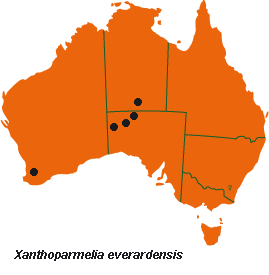



Australian Biological Resources Study
| Checklist of the Lichens of Australia and its Island Territories | ||
| Introduction | A–D | E–O | P–R | S–Z | Oceanic Islands | References | ||
| Xanthoparmelia everardensis (Elix & P.M.Armstr.) Elix & J.Johnst. | ||
| in J.A.Elix, J.Johnston & P.M.Armstrong, Bull. Brit. Mus. (Nat. Hist.), Bot. 15: 242 (1986); Parmelia everardensis Elix & P.M.Armstr., Austral. J. Bot. 31: 473 (1983). T: Mount Illbillee, Everard Ranges, S.A., 25 Nov. 1975, R.B.Filson 15682; holo: MEL. | ||
| Thallus foliose to subcrustose, adnate to tightly adnate, to 5 cm wide. Lobes contiguous, irregular, irregularly branched, 1–3 mm wide; apices subrotund. Upper surface yellow-green, darkening with age, dull, shiny towards lobe apices, emaculate, lacking soredia and isidia; older lobes irregularly fractured and areolae commonly formed. Medulla white. Lower surface dark blackish brown to jet black; rhizines sparse to moderately dense, simple, short, black. Apothecia sessile, 1–2 mm wide; disc concave, dark brown; thalline exciple smooth, entire. Ascospores 8–9 × 4–5 µm. Pycnidia common. Conidia bifusiform, 5–7 × 0.5 µm. CHEMISTRY: cortex K-, UV-; medulla K-, C-, KC-, P-; containing usnic acid, ±atranorin, diffractaic acid (major), barbatic acid (minor) and 4-O-demethylbarbatic acid (trace). |  |
|
| Very rare, endemic, on rock faces with a southerly aspect in south-western W.A., southern N.T. and arid northern S.A. | ||
| Elix (1994z) | ||
| Checklist Index |
| Introduction | A–D | E–O | P–R | S–Z | Oceanic Islands | References |
This work is copyright. Apart from any use as permitted under the Copyright Act 1968, no part may be reproduced by any process without prior written permission from Australian Biological Resources Study. Requests and inquiries concerning reproduction and rights should be addressed in the first instance to Dr P. McCarthy. These pages may not be displayed on, or downloaded to, any other server without the express permission of ABRS.